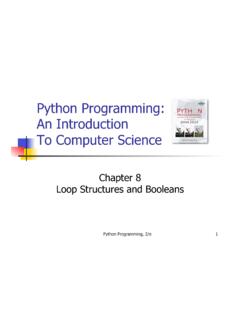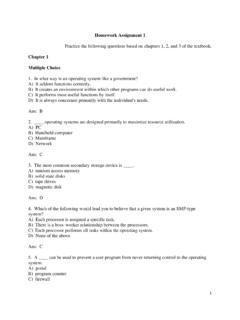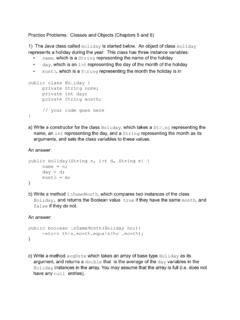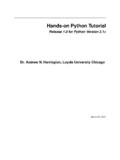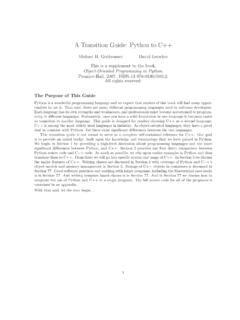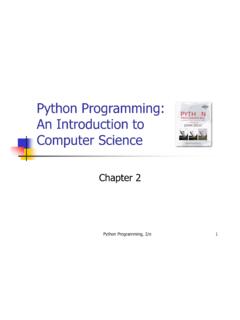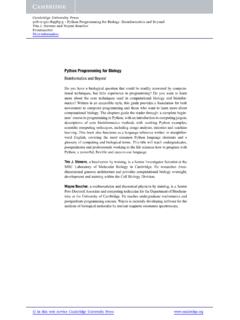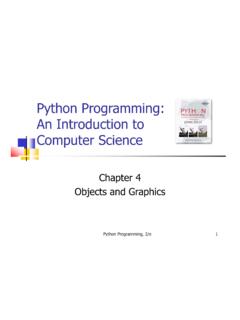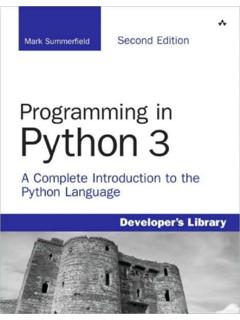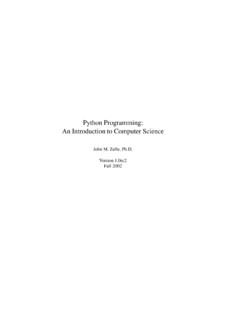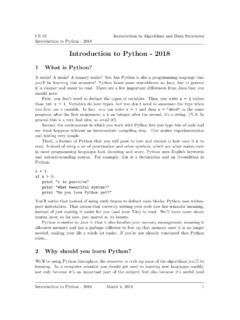Transcription of Python Programing: An Introduction to Computer Science
1 Python programming , 2/e 1 Python programing : An Introduction to Computer Science Chapter 11 Data Collections Python programming , 2/e 2 Objectives n To understand the use of lists (arrays) to represent a collection of related data. n To be familiar with the functions and methods available for manipulating Python lists. n To be able to write programs that use lists to manage a collection of information. Python programming , 2/e 3 Objectives n To be able to write programs that use lists and classes to structure complex data.
2 N To understand the use of Python dictionaries for storing nonsequential collections. Python programming , 2/e 4 Example Problem: Simple Statistics n Many programs deal with large collections of similar information. n Words in a document n Students in a course n Data from an experiment n Customers of a business n Graphics objects drawn on the screen n Cards in a deck Python programming , 2/e 5 Sample Problem: Simple Statistics Let s review some code we wrote in chapter 8: # # A program to average a set of numbers # Illustrates sentinel loop using empty string as sentinel def main(): sum = count = 0 xStr = input("Enter a number (<Enter> to quit) >> ") while xStr !
3 = "": x = eval(xStr) sum = sum + x count = count + 1 xStr = input("Enter a number (<Enter> to quit) >> ") print("\nThe average of the numbers is", sum / count) main() Python programming , 2/e 6 Sample Problem: Simple Statistics n This program allows the user to enter a sequence of numbers, but the program itself doesn t keep track of the numbers that were entered it only keeps a running total. n Suppose we want to extend the program to compute not only the mean, but also the median and standard deviation.
4 Python programming , 2/e 7 Sample Problem: Simple Statistics n The median is the data value that splits the data into equal-sized parts. n For the data 2, 4, 6, 9, 13, the median is 6, since there are two values greater than 6 and two values that are smaller. n One way to determine the median is to store all the numbers, sort them, and identify the middle value. Python programming , 2/e 8 Sample Problem: Simple Statistics n The standard deviation is a measure of how spread out the data is relative to the mean.
5 N If the data is tightly clustered around the mean, then the standard deviation is small. If the data is more spread out, the standard deviation is larger. n The standard deviation is a yardstick to measure/express how exceptional the data is. Python programming , 2/e 9 Sample Problem: Simple Statistics n The standard deviation is n Here is the mean, represents the ith data value and n is the number of data values. n The expression is the square of the deviation of an individual item from the mean.
6 ()21ixxsn = xix()2ixx Python programming , 2/e 10 Sample Problem: Simple Statistics n The numerator is the sum of these squared deviations across all the data. n Suppose our data was 2, 4, 6, 9, and 13. n The mean is n The numerator of the standard deviation is ()()()()()2222 13 + + + + ==== Python programming , 2/e 11 Sample Problem: Simple Statistics n As you can see, calculating the standard deviation not only requires the mean (which can t be calculated until all the data is entered), but also each individual data element!
7 N We need some way to remember these values as they are entered. Python programming , 2/e 12 Applying Lists n We need a way to store and manipulate an entire collection of numbers. n We can t just use a bunch of variables, because we don t know many numbers there will be. n What do we need? Some way of combining an entire collection of values into one object. Python programming , 2/e 13 Lists and Arrays n Python lists are ordered sequences of items. For instance, a sequence of n numbers might be called S: S = s0, s1, s2, s3.
8 , sn-1 n Specific values in the sequence can be referenced using subscripts. n By using numbers as subscripts, mathematicians can succinctly summarize computations over items in a sequence using subscript variables. 10niis = Python programming , 2/e 14 Lists and Arrays n Suppose the sequence is stored in a variable s. We could write a loop to calculate the sum of the items in the sequence like this: sum = 0 for i in range(n): sum = sum + s[i] n Almost all Computer languages have a sequence structure like this, sometimes called an array.
9 Python programming , 2/e 15 Lists and Arrays n A list or array is a sequence of items where the entire sequence is referred to by a single name ( s) and individual items can be selected by indexing ( s[i]). n In other programming languages, arrays are generally a fixed size, meaning that when you create the array, you have to specify how many items it can hold. n Arrays are generally also homogeneous, meaning they can hold only one data type. Python programming , 2/e 16 Lists and Arrays n Python lists are dynamic.
10 They can grow and shrink on demand. n Python lists are also heterogeneous, a single list can hold arbitrary data types. n Python lists are mutable sequences of arbitrary objects. Python programming , 2/e 17 List Operations Operator Meaning <seq> + <seq> Concatenation <seq> * <int-expr> Repetition <seq>[] Indexing len(<seq>) Length <seq>[:] Slicing for <var> in <seq>: Iteration <expr> in <seq> Membership (Boolean) Python programming , 2/e 18 List Operations n Except for the membership check, we ve used these operations before on strings.
